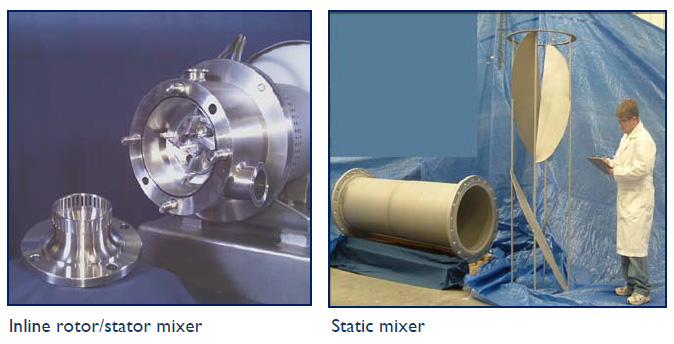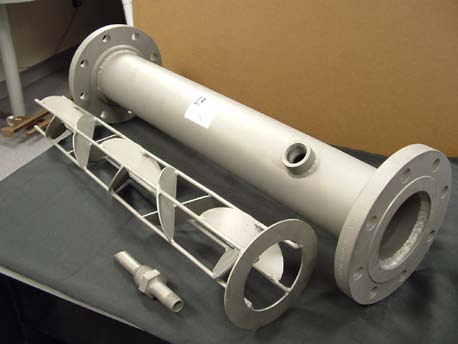Tech Report
Mixers for continuous dilution processes

Technology Brief
Static mixers and rotor/stator mixers are utilized for truly continuous in-line dilution of concentrated solutions. Advantages include high throughput, low space requirement, easy installation, performance predictability and low maintenance.
Dilution in the processing plant
In many production plants, process liquids are prepared from concentrated solutions which are diluted with additional solvent to obtain the proper concentration. Dilution is often designed as a continuous operation to enable efficient and on-demand manufacturing. Some plants utilize large top-agitated batch tanks into which the concentrated solution and solvent are continuously fed and from which the resulting diluted solution is also continuously drawn. However, this set-up requires substantial plant space and hold-up volume. Static mixers and inline rotor/stator mixers simplify continuous dilution processes by eliminating the batch tank. Dilution is fast and product is delivered on-demand.
Static mixers
A static mixer is so called because it has no moving parts. It relies on external pumps to move fluids through an array of mixer elements that are placed inside a pipe. These static mixer elements are a combination of the conduits, plates or baffles designed to force the fluids going through them to divide, recombine, spread, rotate, eddy or swirl.
Process factors considered in static mixer design selection include allowable pressure drop, heating/cooling requirements, flow rates, length of piping, and liquid viscosity.
The advantages of using static mixers for dilution processes are easy installation, low maintenance, low space and energy requirements, short residence times and performance predictability.
Inline high shear mixers
An inline high shear mixer consists of a rotor/stator assembly installed in a housing with inlet and outlet connections. The rotor is connected to a shaft that is directly driven or belt driven by the motor. A mechanical seal is utilized on the rotating shaft to isolate the mix chamber from the environment. Interchangeable stators provide flexibility to adapt to a variety of mixing needs for different product recipes.
Multiple inlet ports allow the mix chamber to accept two or more liquid streams. The mixture is expelled by the rotor through the openings of the stator. The high level of hydraulic shear that is produced generally results in homogenous dilute solutions in just a single pass.
An inline rotor/stator mixer installs much like a centrifugal pump. In a truly continuous process, incoming liquids are metered in at the appropriate rates to achieve the right concentration. Large production-size models equipped with motors up to 100HP are utilized for high throughput requirements.
Sample Application: Acid Dilution

A 15% hydrochloric acid solution is diluted with water at a 1:15 ratio using a Ross LLPD Low Pressure Drop Static Mixer. Both fluids are continuously metered in at 100oF. The carbon steel static mixer elements and internal surfaces of the housing are coated with a 20-25 mil thick fluoropolymer coating for corrosion resistance.